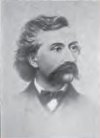The Siege at Lexington
|
|
When Major General Sterling Price's army arrived in the outskirts of Lexington, Missouri on September 12, 1861, he settled in for the night at the fairgrounds a couple of miles outside of town. On the morning of September 13th, Price began his move against the Union garrison in Lexington. But Union commander, Colonel James Mulligan had observed the Missouri State Guard movements and sent the 13th Missouri Volunteer Infantry, under the command of Colonel Everett Peabody, out to meet them. It was simply meant to delay Price and given the Federal defenders more time to improve their entrenchments. |
 |
There was sharp skirmishing and Price was unwilling to bring on a general engagement so withdrew to the fairgrounds. He was getting low on ammunition needed time for his wagon trains to arrive from Warrensburg. Price described this decision in his official report:
"Finding, after sunset, that our ammunition, the most of which had been left behind on the march from Springfield, was nearly exhausted, and that my men, thousands of whom had not eaten a particle in thirty-six hours, required rest and food, I withdrew to the fair ground and encamped there."
Having remained in Lexington throughout, Susan Arnold McCausland was an eyewitness to the events of September. She described the siege in the following way:
"While Gen. Price waited at the fair grounds for the coming up of his ammunition wagons Col. Mulligan continued to strengthen his defenses. During these days of waiting continual skirmishing went on between the soldiers in town and small squads of those outside. The Southerners, becoming impatient of delay, daily cam dashing into town in small groups to give an exchange of shots and out again."
By September 17th, all of Price's wagons full of ammunition and supplies had caught up to him in Lexington, and Price made his move to invest the Federal entrenchments.
- Rains' 8th Division occupied the ground east of the Masonic College, curving around both northeast and southeast of the Federal entrenchments. Bledsoe's Battery and Clark's Battery were deployed behind the 8th Division.
- To the left of Rains' 8th Division was Parsons'6th Division, occupying the ground south and southwest of the Federal entrenchments. Guibor's Battery was deployed behind the 6th Division.
- Rives and Green were behind Parsons' 6th Division southwest of the Federal position near the Missouri River.
- Brigadier General J. H. McBride's 7th Division had take a position due west on the Missouri River behind Harris' 2nd Division.
- Brigadier General Thomas A. Harris had deployed his 2nd Division northwest of the Federal entrenchments and anchored the right flank of Rains' 8th Division.
- The 3rd Division, commanded by Colonel Congrave Jackson (Brigadier General John B. Clark was away on special assignment), was ordered north of the Missouri River to counter the approach of a Union relief column under the command of Brigadier General Samuel Sturgis. Afterwards, the 3rd Division took up a reserve position behind Rains' 8th Division on the east side.
Susan McCausland described what she saw mid-morning on September 18th looking down Main Street:
"What I saw there was an army without any pretense of uniform of any kind, but moving with orderly precision into some determined-upon position. This was Gen. Parson's line, drawn along Main street. Gen. Rains' division took position on the east of the college, with Bledsoe's battery. Gen. Slack's column was extended along the west side, joining that of Gen. Parson on the south. I think that Guibor's Battery was moved about from place to place from time to time, as it was stationed near the intersection of Third and Tenth streets this first day, but went to Gen. Parson's division the next day, then back again west afterwards. On the morning of the second day of the investment, Gen. Harris and Gen. McBride completed the cordon by placing their lines on the north, along the river front. This line was supported throughout by Kelley's and Kneisley's batteries."
The Federal defenders were now surrounded by the Missouri State Guard. They were cut off from their external water supplies, the Missouri River and a spring just to the east of their entrenchments. The only water they had was what they had stored in the Masonic College cistern.

